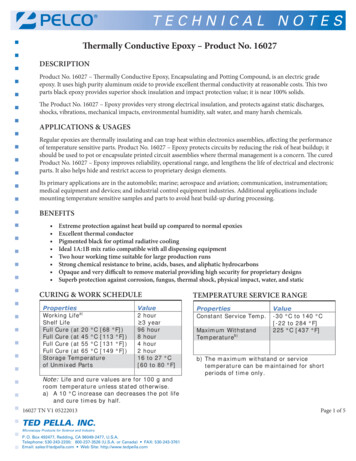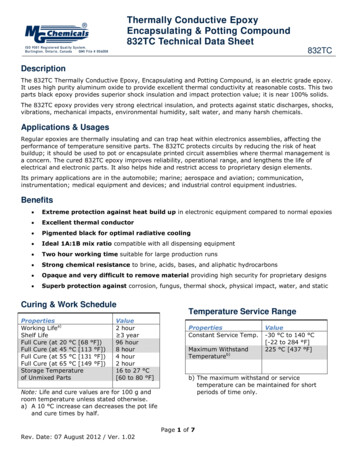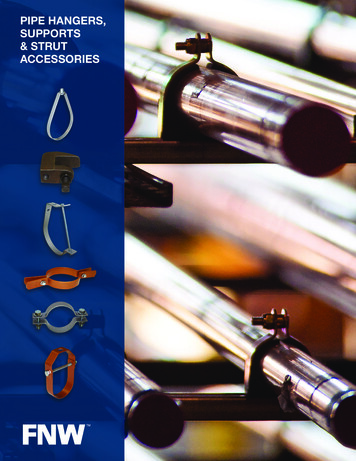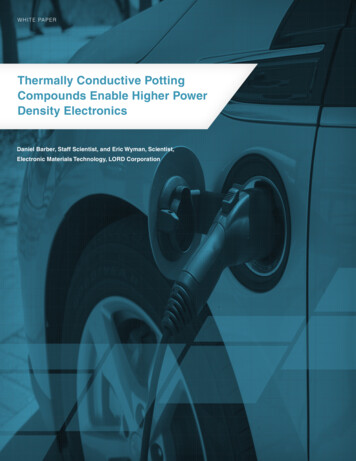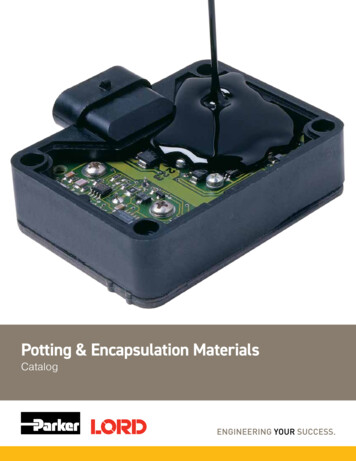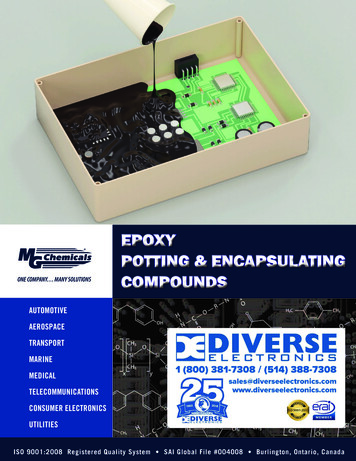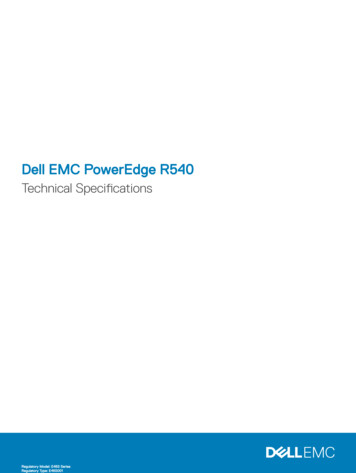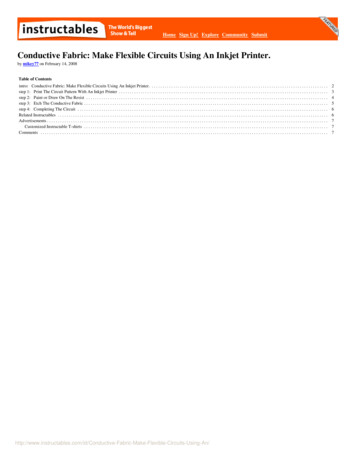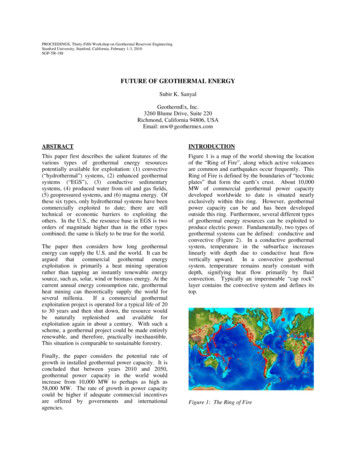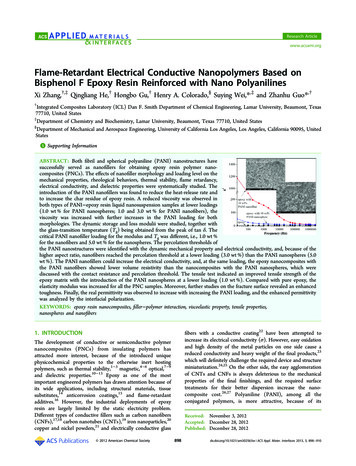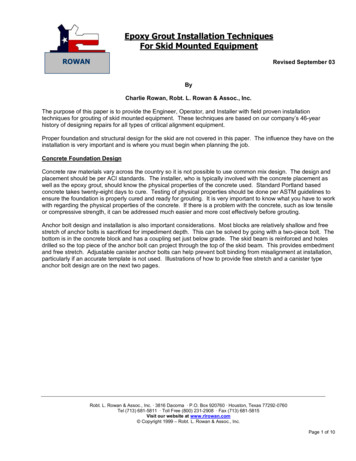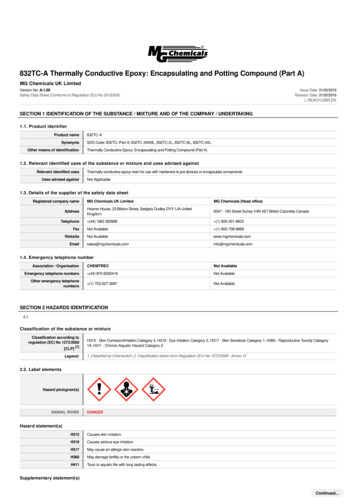
Transcription
832TC-A Thermally Conductive Epoxy: Encapsulating and Potting Compound (Part A)MG Chemicals UK LimitedVersion No: A-1.00Safety Data Sheet (Conforms to Regulation (EU) No 2015/830)Issue Date: 21/03/2019Revision Date: 21/03/2019L.REACH.GBR.ENSECTION 1 IDENTIFICATION OF THE SUBSTANCE / MIXTURE AND OF THE COMPANY / UNDERTAKING1.1. Product IdentifierProduct nameSynonymsOther means of identification832TC-ASDS Code: 832TC–Part A; 832TC-450ML, 832TC-2L, 832TC-8L, 832TC-40LThermally Conductive Epoxy: Encapsulating and Potting Compound (Part A)1.2. Relevant identified uses of the substance or mixture and uses advised againstRelevant identified usesUses advised againstThermally conductive epoxy resin for use with hardeners to pot devices or encapsulate componentsNot Applicable1.3. Details of the supplier of the safety data sheetRegistered company nameAddressTelephoneMG Chemicals UK LimitedMG Chemicals (Head office)Heame House, 23 Bilston Street, Sedgely Dudley DY3 1JA UnitedKingdom9347 - 193 Street Surrey V4N 4E7 British Columbia Canada (44) 1663 362888 (1) 800-201-8822FaxNot Available (1) 800-708-9888WebsiteNot nfo@mgchemicals.comEmail1.4. Emergency telephone numberCHEMTRECNot AvailableEmergency telephone numbersAssociation / Organisation (44) 870-8200418Not AvailableOther emergency telephonenumbers (1) 703-527-3887Not AvailableSECTION 2 HAZARDS IDENTIFICATION2.1.Classification of the substance or mixtureClassification according toregulation (EC) No 1272/2008[CLP][1]Legend:H315 - Skin Corrosion/Irritation Category 2, H319 - Eye Irritation Category 2, H317 - Skin Sensitizer Category 1, H360 - Reproductive Toxicity Category1A, H411 - Chronic Aquatic Hazard Category 21. Classified by Chemwatch; 2. Classification drawn from Regulation (EU) No 1272/2008 - Annex VI2.2. Label elementsHazard pictogram(s)SIGNAL WORDDANGERHazard statement(s)H315Causes skin irritation.H319Causes serious eye irritation.H317May cause an allergic skin reaction.H360May damage fertility or the unborn child.H411Toxic to aquatic life with long lasting effects.Supplementary statement(s)Continued.
Page 2 of 23832TC-A Thermally Conductive Epoxy: Encapsulating and Potting Compound (Part A)Not ApplicablePrecautionary statement(s) PreventionP201Obtain special instructions before use.P280Wear protective gloves/protective clothing/eye protection/face protection.P261Avoid breathing mist/vapours/spray.P273Avoid release to the environment.P272Contaminated work clothing should not be allowed out of the workplace.Precautionary statement(s) ResponseP308 P313IF exposed or concerned: Get medical advice/ attention.P302 P352IF ON SKIN: Wash with plenty of water and soap.P305 P351 P338IF IN EYES: Rinse cautiously with water for several minutes. Remove contact lenses, if present and easy to do. Continue rinsing.P333 P313If skin irritation or rash occurs: Get medical advice/attention.P337 P313If eye irritation persists: Get medical advice/attention.P362 P364Take off contaminated clothing and wash it before reuse.P391Collect spillage.Precautionary statement(s) StorageP405Store locked up.Precautionary statement(s) DisposalP501Dispose of contents/container in accordance with local regulations.2.3. Other hazardsN-methyl-2-pyrrolidoneListed in the European Chemicals Agency (ECHA) Candidate List of Substances of Very High Concern for AuthorisationN-methyl-2-pyrrolidoneListed in the Europe Regulation (EC) No 1907/2006 - Annex XVII (Restrictions may apply)SECTION 3 COMPOSITION / INFORMATION ON INGREDIENTS3.1.SubstancesSee 'Composition on ingredients' in Section 3.23.2.Mixtures1.CAS No2.EC No3.Index No4.REACH No%[weight]NameClassification according to regulation (EC) No 1272/2008 [CLP]1.28064-14-42.Not Available3.Not Available4.Not Available48bisphenol F glycidyl ether/formaldehyde copolymerSkin Corrosion/Irritation Category 2, Eye Irritation Category 2, Chronic Aquatic Hazard Category 2,1.1344-28-12.215-691-63.Not Available4.01-2119529248-35-XXXX47aluminium oxideEUH210 56619-26-XXXX2bisphenol A/ diglycidyl etherresin, liquidEye Irritation Category 2, Chronic Aquatic Hazard Category 2, Skin Sensitizer Category 1, 0009436-62-XXXX1naphtha petroleum, heavy alkylateexposure Category 3 (narcotic effects); H226, H304, H336 [1]1.1333-86-42.215-609-93.Not Available4.01-2119384822-32XXXX 01-2120767622-50XXXX 01-0000016864-62-XXXX0.7carbon blackCarcinogenicity Category 2; H351 85289-22-XXXX0.5(C12-14)alkylglycidyl etherSkin Sensitizer Category 1, Skin Corrosion/Irritation Category 2; H317, H315 430-46-XXXX0.1N-methyl-2-pyrrolidone *Reproductive Toxicity Category 1B, Skin Corrosion/Irritation Category 2, Specific target organtoxicity - single exposure Category 3 (respiratory tract irritation), Eye Irritation Category 2; H360D,Legend:Skin Sensitizer Category 1; H315, H319, H411, H317, EUH205, EUH019 [1]Corrosion/Irritation Category 2; H319, H411, H317, H315 [2]Flammable Liquid Category 3, Aspiration Hazard Category 1, Specific target organ toxicity - singleH315, H335, H319 [2]1. Classified by Chemwatch; 2. Classification drawn from Regulation (EU) No 1272/2008 - Annex VI; 3. Classification drawn from C&L; * EU IOELVsavailableContinued.
Page 3 of 23832TC-A Thermally Conductive Epoxy: Encapsulating and Potting Compound (Part A)SECTION 4 FIRST AID MEASURES4.1. Description of first aid measuresEye ContactSkin ContactIf this product comes in contact with the eyes:Wash out immediately with fresh running water.Ensure complete irrigation of the eye by keeping eyelids apart and away from eye and moving the eyelids by occasionally lifting the upper and lower lids.Seek medical attention without delay; if pain persists or recurs seek medical attention.Removal of contact lenses after an eye injury should only be undertaken by skilled personnel.If skin contact occurs:Immediately remove all contaminated clothing, including footwear.Flush skin and hair with running water (and soap if available).Seek medical attention in event of irritation.InhalationIf fumes, aerosols or combustion products are inhaled remove from contaminated area.Other measures are usually unnecessary.IngestionImmediately give a glass of water.First aid is not generally required. If in doubt, contact a Poisons Information Centre or a doctor.4.2 Most important symptoms and effects, both acute and delayedSee Section 114.3. Indication of any immediate medical attention and special treatment neededTreat symptomatically.Manifestation of aluminium toxicity include hypercalcaemia, anaemia, Vitamin D refractory osteodystrophy and a progressive encephalopathy (mixed dysarthria-apraxia of speech, asterixis,tremulousness, myoclonus, dementia, focal seizures). Bone pain, pathological fractures and proximal myopathy can occur.Symptoms usually develop insidiously over months to years (in chronic renal failure patients) unless dietary aluminium loads are excessive.Serum aluminium levels above 60 ug/ml indicate increased absorption. Potential toxicity occurs above 100 ug/ml and clinical symptoms are present when levels exceed 200 ug/ml.Deferoxamine has been used to treat dialysis encephalopathy and osteomalacia. CaNa2EDTA is less effective in chelating aluminium.[Ellenhorn and Barceloux: Medical Toxicology]Copper, magnesium, aluminium, antimony, iron, manganese, nickel, zinc (and their compounds) in welding, brazing, galvanising or smelting operations all give rise to thermally producedparticulates of smaller dimension than may be produced if the metals are divided mechanically. Where insufficient ventilation or respiratory protection is available these particulates may produce'metal fume fever' in workers from an acute or long term exposure.Onset occurs in 4-6 hours generally on the evening following exposure. Tolerance develops in workers but may be lost over the weekend. (Monday Morning Fever)Pulmonary function tests may indicate reduced lung volumes, small airway obstruction and decreased carbon monoxide diffusing capacity but these abnormalities resolve after several months.Although mildly elevated urinary levels of heavy metal may occur they do not correlate with clinical effects.The general approach to treatment is recognition of the disease, supportive care and prevention of exposure.Seriously symptomatic patients should receive chest x-rays, have arterial blood gases determined and be observed for the development of tracheobronchitis and pulmonary edema.[Ellenhorn and Barceloux: Medical Toxicology]SECTION 5 FIREFIGHTING MEASURES5.1. Extinguishing mediaFoam.Dry chemical powder.BCF (where regulations permit).Carbon dioxide.Water spray or fog - Large fires only.5.2. Special hazards arising from the substrate or mixtureFire IncompatibilityAvoid contamination with oxidising agents i.e. nitrates, oxidising acids, chlorine bleaches, pool chlorine etc. as ignition may result5.3. Advice for firefightersFire FightingFire/Explosion HazardAlert Fire Brigade and tell them location and nature of hazard.Wear full body protective clothing with breathing apparatus.Prevent, by any means available, spillage from entering drains or water course.Use water delivered as a fine spray to control fire and cool adjacent area.Avoid spraying water onto liquid pools.DO NOT approach containers suspected to be hot.Cool fire exposed containers with water spray from a protected location.If safe to do so, remove containers from path of fire.Combustible.Slight fire hazard when exposed to heat or flame.Heating may cause expansion or decomposition leading to violent rupture of containers.On combustion, may emit toxic fumes of carbon monoxide (CO).May emit acrid smoke.Mists containing combustible materials may be explosive.Combustion products include:carbon dioxide (CO2)aldehydesother pyrolysis products typical of burning organic material.When aluminium oxide dust is dispersed in air, firefighters should wear protection against inhalation of dust particles, which can also contain hazardoussubstances from the fire absorbed on the alumina particles.SECTION 6 ACCIDENTAL RELEASE MEASURESContinued.
Page 4 of 23832TC-A Thermally Conductive Epoxy: Encapsulating and Potting Compound (Part A)6.1. Personal precautions, protective equipment and emergency proceduresSee section 86.2. Environmental precautionsSee section 126.3. Methods and material for containment and cleaning upMinor Spills·In the event of a spill of a reactive diluent, the focus is on containing the spill to prevent contamination of soil and surface or ground water.·If irritating vapors are present, an approved air-purifying respirator with organic vapor canister is recommended for cleaning up spills andleaks.·For small spills, reactive diluents should be absorbed with sand.Environmental hazard - contain spillage.Clean up all spills immediately.Avoid breathing vapours and contact with skin and eyes.Control personal contact with the substance, by using protective equipment.Contain and absorb spill with sand, earth, inert material or vermiculite.Wipe up.Place in a suitable, labelled container for waste disposal.Environmental hazard - contain spillage.Chemical Class: phenols and cresolsFor release onto land: recommended sorbents listed in order of ATIONSLAND SPILL - SMALLcross-linked polymer - particulate1shovelshovelR, W, SScross-linked polymer - pillow1throwpitchforkR, DGC, RTwood fiber - pillow1throwpitchforkR, P, DGC, RTfoamed glass - pillow2shovelshovelR, W, P, DGCsorbent clay - particulate2shovelshovelR, I, Pwood fibre - particulate3shovelshovelR, W, P, DGCLAND SPILL - MEDIUMMajor Spillscross-linked polymer - particulate1blowerskiploaderR,W, SScross-linked polymer - pillow2throwskiploaderR, DGC, RTsorbent clay - particulate3blowerskiploaderR, I, Ppolypropylene - particulate3blowerskiploaderR, SS, DGCwood fiber - particulate4blowerskiploaderR, W, P, DGCexpanded moneral - particulate4blowerskiploaderR, I, W, P, DGCLegendDGC: Not effective where ground cover is denseR; Not reusableI: Not incinerableP: Effectiveness reduced when rainyRT:Not effective where terrain is ruggedSS: Not for use within environmentally sensitive sitesW: Effectiveness reduced when windyReference: Sorbents for Liquid Hazardous Substance Cleanup and Control;R.W Melvold et al: Pollution Technology Review No. 150: Noyes Data Corporation 1988Industrial spills or releases of reactive diluents are infrequent and generally contained. If a large spill does occur, the material should be captured,collected, and reprocessed or disposed of according to applicable governmental requirements.An approved air-purifying respirator with organic-vapor canister is recommended for emergency work.Moderate hazard.Clear area of personnel and move upwind.Alert Fire Brigade and tell them location and nature of hazard.Wear breathing apparatus plus protective gloves.Prevent, by any means available, spillage from entering drains or water course.No smoking, naked lights or ignition sources.Increase ventilation.Stop leak if safe to do so.Contain spill with sand, earth or vermiculite.Collect recoverable product into labelled containers for recycling.Absorb remaining product with sand, earth or vermiculite.Collect solid residues and seal in labelled drums for disposal.Wash area and prevent runoff into drains.If contamination of drains or waterways occurs, advise emergency services.6.4. Reference to other sectionsPersonal Protective Equipment advice is contained in Section 8 of the SDS.SECTION 7 HANDLING AND STORAGE7.1. Precautions for safe handlingContinued.
Page 5 of 23832TC-A Thermally Conductive Epoxy: Encapsulating and Potting Compound (Part A)Avoid all personal contact, including inhalation.Wear protective clothing when risk of exposure occurs.Use in a well-ventilated area.Prevent concentration in hollows and sumps.DO NOT enter confined spaces until atmosphere has been checked.Avoid smoking, naked lights or ignition sources.Avoid contact with incompatible materials.When handling, DO NOT eat, drink or smoke.Keep containers securely sealed when not in use.Avoid physical damage to containers.Always wash hands with soap and water after handling.Work clothes should be laundered separately.Use good occupational work practice.Observe manufacturer's storage and handling recommendations contained within this SDS.Atmosphere should be regularly checked against established exposure standards to ensure safe working conditions.DO NOT allow clothing wet with material to stay in contact with skinSafe handlingFire and explosion protectionSee section 5Store in original containers.Keep containers securely sealed.Store in a cool, dry, well-ventilated area.Store away from incompatible materials and foodstuff containers.Protect containers against physical damage and check regularly for leaks.Observe manufacturer's storage and handling recommendations contained within this SDS.Other information7.2. Conditions for safe storage, including any incompatibilitiesMetal can or drumPackaging as recommended by manufacturer.Check all containers are clearly labelled and free from leaks.Suitable containerStorage incompatibilityFor aluminas (aluminium oxide):Incompatible with hot chlorinated rubber.In the presence of chlorine trifluoride may react violently and ignite.-May initiate explosive polymerisation of olefin oxides including ethylene oxide.-Produces exothermic reaction above 200 C with halocarbons and an exothermic reaction at ambient temperatures with halocarbons in the presence ofother metals.-Produces exothermic reaction with oxygen difluoride.-May form explosive mixture with oxygen difluoride.-Forms explosive mixtures with sodium nitrate.-Reacts vigorously with vinyl acetate.Aluminium oxide is an amphoteric substance, meaning it can react with both acids and bases, such as hydrofluoric acid and sodium hydroxide, acting as anacid with a base and a base with an acid, neutralising the other and producing a salt.Phenols are incompatible with strong reducing substances such as hydrides, nitrides, alkali metals, and sulfides.Avoid use of aluminium, copper and brass alloys in storage and process equipment.Heat is generated by the acid-base reaction between phenols and bases.Phenols are sulfonated very readily (for example, by concentrated sulfuric acid at room temperature), these reactions generate heat.Phenols are nitrated very rapidly, even by dilute nitric acid.Nitrated phenols often explode when heated. Many of them form metal salts that tend toward detonation by rather mild shock.Glycidyl ethers:may form unstable peroxides on storage in air ,light, sunlight, UV light or other ionising radiation, trace metals - inhibitor should be maintained atadequate levelsmay polymerise in contact with heat, organic and inorganic free radical producing initiatorsmay polymerise with evolution of heat in contact with oxidisers, strong acids, bases and aminesreact violently with strong oxidisers, permanganates, peroxides, acyl halides, alkalis, ammonium persulfate, bromine dioxideattack some forms of plastics, coatings, and rubberReactive diluents are stable under recommended storage conditions, but can decompose at elevated temperatures.In some cases, decomposition cancause pressure build-up in closed systems.Avoid cross contamination between the two liquid parts of product (kit).If two part products are mixed or allowed to mix in proportions other than manufacturer's recommendation, polymerisation with gelation and evolution ofheat (exotherm) may occur.This excess heat may generate toxic vapourAvoid reaction with amines, mercaptans, strong acids and oxidising agents7.3. Specific end use(s)See section 1.2SECTION 8 EXPOSURE CONTROLS / PERSONAL PROTECTION8.1. Control parametersDERIVED NO EFFECT LEVEL (DNEL)Not AvailablePREDICTED NO EFFECT LEVEL (PNEC)Not AvailableOCCUPATIONAL EXPOSURE LIMITS (OEL)INGREDIENT DATASourceIngredientMaterial nameTWASTELPeakNotesUK Workplace Exposure Limits(WELs)aluminium oxideAluminium oxides: respirable dust4 mg/m3Not AvailableNot AvailableNot AvailableContinued.
Page 6 of 23832TC-A Thermally Conductive Epoxy: Encapsulating and Potting Compound (Part A)UK Workplace Exposure Limits(WELs)aluminium oxideAluminium oxides: inhalable dust10 mg/m3Not AvailableNot AvailableNot AvailableUK Workplace Exposure Limits(WELs)carbon blackCarbon black3.5 mg/m37 mg/m3Not AvailableNot AvailableEU Consolidated List of IndicativeOccupational Exposure LimitValues ne10 ppm / 40 mg/m380 mg/m3 / 20 ppmNot AvailableskinUK Workplace Exposure lidone10 ppm / 40 mg/m380 mg/m3 / 20 ppmNot AvailableSkEMERGENCY LIMITSIngredientMaterial nameTEEL-1TEEL-2TEEL-3bisphenol F glycidyl ether/formaldehyde copolymerPhenol, polymer with formaldehyde, oxiranylmethyl ether30 mg/m3330 mg/m32,000 mg/m3aluminium oxideAluminum oxide; (Alumina)5.7 mg/m315 mg/m325 mg/m3bisphenol A/ diglycidyl ether resin,liquidEpoxy resin includes EPON 1001, 1007, 820, ERL-279590 mg/m3990 mg/m35,900 mg/m3carbon blackCarbon black9 mg/m399 mg/m3590 mg/m3N-methyl-2-pyrrolidoneMethyl 2-pyrrolidinone, 1-; (N-Methylpyrrolidone)30 ppm32 ppm190 ppmIngredientOriginal IDLHRevised IDLHbisphenol F glycidyl ether/formaldehyde copolymerNot AvailableNot Availablealuminium oxideNot AvailableNot Availablebisphenol A/ diglycidyl ether resin,liquidNot AvailableNot Availablenaphtha petroleum, heavy alkylateNot AvailableNot Availablecarbon black1,750 mg/m3Not Available(C12-14)alkylglycidyl etherNot AvailableNot AvailableN-methyl-2-pyrrolidoneNot AvailableNot AvailableMATERIAL DATAfor N-methyl-2-pyrrolidone (NMP):Reports of skin and eye irritation and chronic headaches have been reported in workers exposed to 1-methyl-2-pyrrolidone. The Australian ES is based on a 10-fold uncertainty factor of theno-observable-adverse-effect level (NOAEL) of 24 ppm where adverse respiratory effects were observed in a 4-week inhalation study in rats.For aluminium oxide and pyrophoric grades of aluminium:Twenty seven year experience with aluminium oxide dust (particle size 96% 1,2 um) without adverse effects either systemically or on the lung, and at a calculated concentration equivalent to 2mg/m3 over an 8-hour shift has lead to the current recommendation of the TLV-TWA.The limit should also apply to aluminium pyro powders whose toxicity is reportedly greater than aluminium dusts and should be protective against lung changes.For aluminium oxide:The experimental and clinical data indicate that aluminium oxide acts as an 'inert' material when inhaled and seems to have little effect on the lungs nor does it produce significant organic diseaseor toxic effects when exposures are kept under reasonable control.[Documentation of the Threshold Limit Values], ACGIH, Sixth EditionFor epichlorohydrinOdour Threshold Value: 0.08 ppmNOTE: Detector tubes for epichlorohydrin, measuring in excess of 5 ppm, are commercially available.Exposure at or below the recommended TLV-TWA is thought to minimise the potential for adverse respiratory, liver, kidney effects. Epichlorohydrin has been implicated as a human skin sensitiser,hence individuals who are hypersusceptible or otherwise unusually responsive to certain chemicals may NOT be adequately protected from adverse health effects.Odour Safety Factor (OSF)OSF 0.54 (EPICHLOROHYDRIN)8.2. Exposure controlsEngineering controls are used to remove a hazard or place a barrier between the worker and the hazard. Well-designed engineering controls can behighly effective in protecting workers and will typically be independent of worker interactions to provide this high level of protection.The basic types of engineering controls are:Process controls which involve changing the way a job activity or process is done to reduce the risk.Enclosure and/or isolation of emission source which keeps a selected hazard 'physically' away from the worker and ventilation that strategically 'adds' and'removes' air in the work environment. Ventilation can remove or dilute an air contaminant if designed properly. The design of a ventilation system mustmatch the particular process and chemical or contaminant in use.Employers may need to use multiple types of controls to prevent employee overexposure.8.2.1. Appropriate engineeringcontrolsGeneral exhaust is adequate under normal operating conditions. Local exhaust ventilation may be required in specific circumstances. If risk ofoverexposure exists, wear approved respirator. Correct fit is essential to obtain adequate protection. Provide adequate ventilation in warehouse or closedstorage areas. Air contaminants generated in the workplace possess varying 'escape' velocities which, in turn, determine the 'capture velocities' of freshcirculating air required to effectively remove the contaminant.Type of Contaminant:Air Speed:solvent, vapours, degreasing etc., evaporating from tank (in still air).0.25-0.5 m/s (50-100f/min)aerosols, fumes from pouring operations, intermittent container filling, low speed conveyer transfers, welding, spray drift, platingacid fumes, pickling (released at low velocity into zone of active generation)0.5-1 m/s (100-200f/min.)direct spray, spray painting in shallow booths, drum filling, conveyer loading, crusher dusts, gas discharge (active generationinto zone of rapid air motion)1-2.5 m/s (200-500f/min.)Continued.
Page 7 of 23832TC-A Thermally Conductive Epoxy: Encapsulating and Potting Compound (Part A)grinding, abrasive blasting, tumbling, high speed wheel generated dusts (released at high initial velocity into zone of very highrapid air motion).2.5-10 m/s(500-2000 f/min.)Within each range the appropriate value depends on:Lower end of the rangeUpper end of the range1: Room air currents minimal or favourable to capture1: Disturbing room air currents2: Contaminants of low toxicity or of nuisance value only.2: Contaminants of high toxicity3: Intermittent, low production.3: High production, heavy use4: Large hood or large air mass in motion4: Small hood-local control onlySimple theory shows that air velocity falls rapidly with distance away from the opening of a simple extraction pipe. Velocity generally decreases with thesquare of distance from the extraction point (in simple cases). Therefore the air speed at the extraction point should be adjusted, accordingly, afterreference to distance from the contaminating source. The air velocity at the extraction fan, for example, should be a minimum of 1-2 m/s (200-400 f/min) forextraction of solvents generated in a tank 2 meters distant from the extraction point. Other mechanical considerations, producing performance deficits withinthe extraction apparatus, make it essential that theoretical air velocities are multiplied by factors of 10 or more when extraction systems are installed orused.8.2.2. Personal protectionEye and face protectionSkin protectionHands/feet protectionSafety glasses with side shields.Chemical goggles.Contact lenses may pose a special hazard; soft contact lenses may absorb and concentrate irritants. A written policy document, describing the wearingof lenses or restrictions on use, should be created for each workplace or task. This should include a review of lens absorption and adsorption for theclass of chemicals in use and an account of injury experience. Medical and first-aid personnel should be trained in their removal and suitable equipmentshould be readily available. In the event of chemical exposure, begin eye irrigation immediately and remove contact lens as soon as practicable. Lensshould be removed at the first signs of eye redness or irritation - lens should be removed in a clean environment only after workers have washed handsthoroughly. [CDC NIOSH Current Intelligence Bulletin 59], [AS/NZS 1336 or national equivalent]See Hand protection belowNOTE:The material may produce skin sensitisation in predisposed individuals. Care must be taken, when removing gloves and other protective equipment, toavoid all possible skin contact.Contaminated leather items, such as shoes, belts and watch-bands should be removed and destroyed.The selection of suitable gloves does not only depend on the material, but also on further marks of quality which vary from manufacturer to manufacturer.Where the chemical is a preparation of several substances, the resistance of the glove material can not be calculated in advance and has therefore to bechecked prior to the application.The exact break through time for substances has to be obtained from the manufacturer of the protective gloves and.has to be observed when making a finalchoice.Personal hygiene is a key element of effective hand care. Gloves must only be worn on clean hands. After using gloves, hands should be washed and driedthoroughly. Application of a non-perfumed moisturiser is recommended.Suitability and durability of glove type is dependent on usage. Important factors in the selection of gloves include:·frequency and duration of contact,·chemical resistance of glove material,·glove thickness and·dexteritySelect gloves tested to a relevant standard (e.g. Europe EN 374, US F739, AS/NZS 2161.1 or national equivalent).·When prolonged or frequently repeated contact may occur, a glove with a protection class of 5 or higher (breakthrough time greater than240 minutes according to EN 374, AS/NZS 2161.10.1 or national equivalent) is recommended.·When only brief contact is expected, a glove with a protection class of 3 or higher (breakthrough time greater than 60 minutes accordingto EN 374, AS/NZS 2161.10.1 or national equivalent) is recommended.·Some glove polymer types are less affected by movement and this should be taken into account when considering gloves for long-termuse.·Contaminated gloves should be replaced.As defined in ASTM F-739-96 in any application, gloves are rated as:·Excellent when breakthrough time 480 min·Good when breakthrough time 20 min·Fair when breakthrough time 20 min·Poor when glove material degradesFor general applications, gloves with a thickness typically greater than 0.35 mm, are recommended.It should be emphasised that glove thickness is not necessarily a good predictor of glove resistance to a specific chemical, as the permeation efficiency ofthe glove will be dependent on the exact composition of the glove material. Therefore, glove selection should also be based on consideration of the taskrequirements and knowledge of breakthrough times.Glove thickness may also vary depending on the glove manufacturer, the glove type and the glove model. Therefore, the manufacturers’ technical datashould always be taken into account to ensure selection of the most appropriate glove for the task.Note: Depending on the activity being conducted, gloves of varying thickness may be required for specific tasks. For example:·Thinner gloves (down to 0.1 mm or less) may be required where a high degree of manual dexterity is needed. However, these gloves areonly likely to give short duration protection and would normally be just for single use applications, then disposed of.·Thicker gloves (up to 3 mm or more) may be required where there is a mechanical (as well as a chemical) risk i.e. where there isabrasion or puncture potentialGloves must only be worn on clean hands. After using gloves, hands should be washed and dried thoroughly. Application of a non-perfumed moisturiser isrecommended.When handling liquid-grade epoxy resins wear chemically protective gloves , boots and aprons.The performance, based on breakthrough times ,of:·Ethyl Vinyl Alcohol (EVAL laminate) is generally excellent·Butyl Rubber ranges from excellent to good·Nitrile Butyl Rubber (NBR) from excellent to fair.·Neoprene from excellent to fair·Polyvinyl (PVC) from excellent to poorAs defined in ASTM F-739-96·Excellent breakthrough time
832TC-A Thermally Conductive Epoxy: Encapsulating and Potting Compound (Part A) MG Chemicals UK Limited Version No: A-1.00 Safety Data Sheet (Conforms to Regulation (EU) No 2015/830) Issue Date: 21/03/2019 Revision Date: 21/03/2019 L.REACH.GBR.EN SECTION 1 IDENTIFICATION OF THE SUBSTANCE / MIXTURE AND OF THE COMPANY / UNDERTAKING 1.1. Product .
